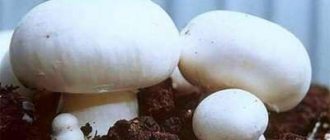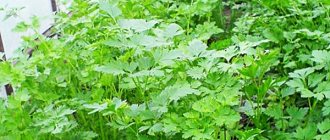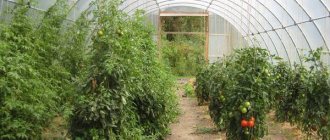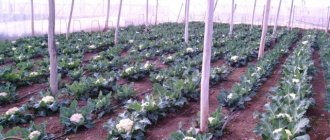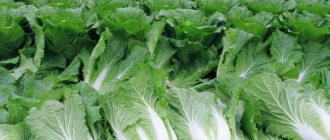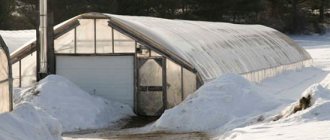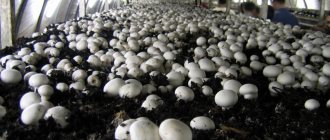Potatoes are one of the most significant and desired products on every table. Many households stock up on potatoes with the onset of winter, because with the help of this vegetable you can prepare many nutritious and tasty dishes. Growing potatoes yourself in a greenhouse is not only pleasant, but also profitable. In a heated greenhouse, you can plant potato tubers in December and harvest them in early spring. To get a good harvest, it is necessary to use special growing technology and avoid mistakes when choosing an early potato variety. Our article contains tips on growing early potatoes, a greenhouse planting scheme, as well as an interesting video.
Planting potatoes in a greenhouse in winter
In greenhouse conditions, you can grow high-quality, tasty potatoes, and if you follow basic recommendations, the yield per 1 m² will be about 50 kg.
Any type of greenhouse can be used to grow potatoes:
- from film - it is based on a metal or wooden frame, which is covered with a durable film. The design is characterized by the availability and cheapness of materials, but is fragile and less warm;
- polycarbonate — maintains the absolute integrity of the structure, is popular among farms, but has a high cost;
- glass- durable and reliable construction, which is based on a wooden frame; impact-resistant double-glazed windows are used for strength. The disadvantages of this design are the need to build a foundation and the high cost.
Advantages
Growing potatoes in a greenhouse can become a profitable business, as it allows you to harvest fruits for 8 months, without interruption, alternating planting periods.
- In addition, greenhouse cultivation of tubers has many other advantages:
- consistently high yields due to the ability to independently regulate growing conditions;
- ease of planting care and ease of harvesting;
- a minimum number of pests that, when grown in the usual way, severely affect the beds;
- maximum effect in the fight against potato diseases, thanks to the closed space and high concentration of drugs inside the closed area;
- the ability to grow tubers in several tiers, in large wooden pallets, which allows you to significantly save space.
Flaws
Despite the fact that growing potatoes in a greenhouse has a lot of advantages, it is not without its disadvantages. For example, to create a greenhouse that is suitable for use in winter, you will have to incur considerable costs to create a heating system that will be regulated depending on environmental conditions. Greenhouse plantings require additional attention in the form of fertilization, maintaining recommended humidity levels and regular watering to achieve maximum yield.
How to plant potatoes in winter in a greenhouse
To grow potatoes in a greenhouse, you must follow the basic rules of agricultural technology, choose a good variety and carry out proper planting. Therefore, let's look at how to do this in more detail.
Which varieties are best to plant?
The key to a good harvest is the correctly selected variety for cultivation, since not all varieties are suitable for cultivation in greenhouses. For these purposes, it is recommended to give preference to extra-early or early varieties that have a minimal growing season and quickly produce a harvest.
Among the best varieties for greenhouses are:
- Kharkov early is a high-yielding variety, distinguished by the presence of white tubers, which are covered with a dense peel that is resistant to mechanical damage. The variety is especially valued due to its increased resistance to high temperatures and overheating of the above-ground parts of plants;
- Priekulsky early - has round-shaped tubers, white when cut. Shoots germinate in a short time, the variety is unpretentious to growing conditions and can easily tolerate dense territory. It has a serious drawback - strong susceptibility to late blight;
- Good luck - oval-shaped potatoes with light flesh, grow on different types of soil, tolerate waterlogging and drought well. Often affected by late blight;
- Spark - produces a harvest of large, round-shaped tubers with light cream-colored pulp. The advantage of the variety is its high resistance to late blight, cancer and blackleg, but it can be affected by scab and rhizoctonia.
- The tubers are placed in grooves according to the planting pattern, so that the sprouts are directed upward.
- The grooves are carefully sprinkled with moist, loose soil or humus at the soil level.
- The bed is not watered for 20 days after planting the tubers, so as not to provoke rotting of the planting material.
- The temperature in the greenhouse during planting is maintained at +13...+20°C.
Landing dates
In heated greenhouses, it is recommended to plant potatoes at the end of August for a harvest in early December or at the end of February - beginning of March for harvesting mature tubers in late spring. Summer planting in a greenhouse is practiced only if it is possible to condition the structure, since the air temperature in the greenhouse is significantly higher than the temperature in the open air due to the greenhouse effect created.
Unheated greenhouses are suitable for planting potatoes only in the spring, since it will not be possible to maintain the required temperature in winter. In order for the greenhouse to be as warm as possible, it is recommended to build it with a pointed roof and install it in the direction from west to east. Planting tubers is postponed until there is at least 10 hours of daylight per day.
The soil temperature when planting in a greenhouse should be at +6°C, and it should be measured at a depth of at least 10 cm. The air temperature in the greenhouse for normal germination of tubers should be +18...+20°C. In a heated greenhouse, you can set the required parameters yourself, but in an unheated greenhouse, you will have to wait until it gets a little warmer outside. Depending on the growing region, the period for planting potatoes in an unheated greenhouse may be within the last days of March or early April.
In a heated greenhouse, the growing region does not matter. Tubers, provided the plantings are provided with the recommended conditions, grow well in any region. In unheated greenhouses, it is preferable to plant in the Southern and Central regions.
Selecting a location
Potatoes grow well on loose soils , and their composition is not so important, provided that fertilizers are regularly applied. The quantity and quality of the harvest directly depends on the density of the soil in the place where the tubers form, so the greenhouse should be located on sandy loam soil or light chernozem. More dense and heavy soils are cultivated by adding river sand in large quantities.
If tubers are planted in winter, when the plant lacks sunlight, the greenhouse should be placed in a well-lit area located on the south side of the bed. In winter or autumn, sunny days are rare, and given that potatoes are a light-loving plant, they require additional lighting in the form of equipping the greenhouse with artificial light sources.
Video: how to properly position a greenhouse on a site
Windiness on the site has virtually no effect on potato plantings, since they are protected by the greenhouse structure. But the construction of a greenhouse in regions with strong gusts of wind must be carried out on a foundation and have a strong, strong frame. For example, lightweight domed greenhouses covered with film can be severely damaged by sharp gusts of wind and will not protect the plantings inside, while heavy polycarbonate or glass greenhouses are just suitable for these purposes.
Planting potatoes is excluded in places where groundwater levels are high to the soil surface. The problem of high groundwater levels can be solved by placing the bed on a ridge or artificial hill. It is not recommended to build a greenhouse in low-lying areas of the garden bed to prevent flooding in the spring or during periods of heavy rain.
Preparing the bed
The soil is prepared for planting potatoes during the period when the greenhouse is not in use. Depleted soil must be nourished with useful substances so that the next harvest will be abundant and of high quality. In the fall, regardless of the period of planting tubers, nitrogen (25 g) and potassium (15 g) fertilizers per 1 m² are applied to the soil for digging. It is necessary to dig up the soil to a depth of at least 30 cm, while simultaneously removing weeds and root debris.
Selection and preparation of planting material
Large and medium-sized tubers that do not have mechanical damage, traces of disease or exposure to pests are suitable for planting. When preparing tuber crops for storage, it is better to select planting material that has grown under large and powerful bushes. Preparing potatoes for planting consists of treating them with a solution of potassium permanganate and germinating the tubers for the rapid appearance of shoots after planting in the soil.
Planting pattern and depth
In a greenhouse, it is most convenient to plant potatoes in furrows, while maintaining a certain pattern: depressions in the soil should be made at a distance of 50 to 60 cm between rows. The depth of the furrows should be about 5-6 cm, the potatoes are placed in trenches at a distance of 20–40 cm, depending on the vigor of the bush of a particular variety and the size of the planting material.
Planting and growing technology
Let's look at the step-by-step process of planting potatoes in a bed prepared in advance.
Necessary conditions for obtaining an early harvest
You can grow early potatoes under a film cover, following certain agrotechnical rules. What conditions must be met in order to harvest the crop at the beginning of summer?
First, purchase high-quality planting material for early varieties of potatoes, for example, Red Scarlett, Bellarosa, Riviera or others at your discretion. It is better to choose large tubers and always vernalized, or do it yourself.
Secondly, planting potatoes should be done when the earth has not yet fully warmed up, that is, as early as possible and be sure to use a reliable film cover.
Thirdly, careful care, timely watering and fertilizing should be carried out, corresponding to the characteristics of early varieties.
Further care
After planting, it is recommended to immediately cover the potatoes with plastic film, which will create a greenhouse effect and accelerate the germination of shoots. It is necessary to cover the bed with large pieces of film, securing the edges with bricks. After the first shoots appear, the film is removed and no longer used.
When maintaining the recommended temperature in the greenhouse, the first shoots appear 10–12 days after planting the tubers.
At different stages of bush development, the following temperature regime must be observed:
The first time the beds are watered after the emergence of seedlings. Watering is done by sprinkling , moistening the row spacing. For irrigation, use settled water at room temperature. It is very important to pay special attention to watering potato plants during the flowering period; at this time, the regularity of watering is increased, moistening the soil every other day, bringing the soil moisture to 90%.
During the process of growing potatoes, it is imperative to add high-quality fertilizers to the soil - this is the only way to get a bountiful harvest of tubers. The best solution for fertilizing is considered to be a solution of rotted chicken manure (prepared in the ratio: 1 part fertilizing to 15 parts water). Each bush should be watered with the prepared product, at the root, in an amount of 1 liter. It is necessary to feed the bushes immediately after the first shoots appear.
Advice from experienced gardeners
List of tips to help grow quality root vegetables:
- To ensure that the quality of the harvest is at a high level, choose large-sized tubers for planting, without damage, traces of disease or pest activity.
- It is very important to maintain a distance between the rows of potatoes, which will allow each bush to receive a sufficient amount of sunlight and dry out faster after watering to prevent the development of rot and mold.
- If the selected planting material is very large, you can cut the tuber into 2 parts; it must be planted with the cut down.
- Potatoes are planted in acidic soil after neutralizing excess acidity and restoring a slightly acidic or neutral reaction. To do this, use dolomite flour - 0.5-0.6 kg per 1 m², spreading it in a layer on the substrate.
Thus, growing potatoes in a greenhouse almost all year round is very profitable for sale, since young tubers are expensive in winter. The growing process is complicated only by the construction of a heated greenhouse, and planting and caring for potatoes does not take much time and effort.
What does productivity depend on?
As experienced summer residents assure, from one cubic meter you can get up to one bag of potatoes. Productivity, first of all, depends on the condition of the soil and the quality of the planting material itself. It is also important to provide timely fertilizing and remove pests.
The distance between the beds also has a significant impact on the volume of the final harvest. By observing these parameters, the tubers will better absorb sunlight, and the soil will dry out faster after watering. If everything is calculated correctly and the planting process is approached wisely, then in the end you can be guaranteed to get a good harvest.
Growing potatoes in a greenhouse
New Charlotte potatoes have a wonderful taste and their skins do not burst when cooked.
Planting : December-February and July, August
Cleaning : October-December and March-May
If you heat your greenhouse, you can grow potatoes in it 8 months a year. Plant early-ripening varieties in December for a harvest in early spring. Or at the end of summer to harvest new potatoes for Christmas.
The tubers are planted in pots with a diameter of 23 cm, and when the above-ground part of the plant develops, possibly requiring support, they are transplanted into seedling bags or larger containers. Water regularly, but not abundantly. To make harvesting longer, dig out the top tubers from a large pot and fill the empty space with compost - it will form new tubers. Remember to plant seed potatoes from garden centers or specialty mail order suppliers.
Cultivation
Difficulties . With proper care there are no difficulties, but the harvest may be small.
Landing . Plant 1-2 seed potato tubers in pots with a diameter of at least 30 cm. Place a layer of all-purpose compost or soil contained in seedling bags about 10 cm thick on the bottom. Place the tubers on top and cover with a layer of compost of the same thickness. When the shoots that emerge from under the soil reach a height of 15 cm, cover them again with compost so that they only peek out from under it. Repeat this until the pot is full. Plant new batches of tubers in succession over several weeks to allow the harvest to mature gradually.
Care . Keep pots of potatoes planted in late summer outdoors until cool fall weather sets in, and then move them to a heated greenhouse. You can continue planting in the greenhouse. Water well, but not too much.
Cleaning . You can either empty the pot and pick out all the tubers, after which the plant will die, or you can pick out the tubers from the top layer and then add compost. The last procedure can be repeated 2-3 times. When the tops die, either dig up the tubers immediately or leave them in pots and don't water until the potatoes are needed. In cold weather, it is perfectly preserved in this way for several weeks.
Storage . You will not reap large harvests, so immediately after harvesting, use the potatoes for food.
Recommendation for the method of germinating seedlings in pots
This method is used by gardeners quite rarely, and completely undeservedly. Since this stage is intermediate between vernalization and planting potatoes in the ground. It allows the seedlings to awaken to further development, and a completely unique microclimate is formed in the clay container, helping to contain pathogenic microorganisms.
This is the main difference between the method with plastic bottles, which only create a certain greenhouse effect. In this case, the formation of roots and the first leaves occurs. That is, the further growing season is reduced, and developed, healthy and strong plants are planted in the ground, which allows you to get not only an early, but also a heavy harvest.
To do this, soil fertilized with nitrogen, potassium and phosphorus compounds is poured into clay pots (you can replace them with wood ash), and 1 sprouted potato is planted in each pot. After this, water the planting and place the pot on a well-lit window.
The varieties are worth trying.
Carlingford . _ _ The tubers are smooth and white inside. Good in salads and boiled.
Maris Peer . _ _ _ The tubers are small but numerous.
Nicola . _ _ _ The tubers are hard, “waxy”, yellow.
Orla . _ _ _ The tubers are pale on the outside, yellow on the inside. Resistant to late blight.
Charlotte . _ Good in salads and boiled.
You can learn about other varieties in the article “The best varieties of potatoes.”
Preparing seed and soil for planting
Before the time comes to worry about choosing methods for caring for plants, you need to properly prepare the tubers and substrate for good potato growth. This needs to be done in the fall.
For seeds, you should select tubers about 4-5 cm in diameter. Potatoes that are too large will have to be cut when planting, and in closed ground conditions this can provoke an outbreak of diseases in plants when a large mass of tubers begins to rot. When using small-fraction tubers, this does not happen: they remain intact even during the formation of a new crop.
After selecting the seed material, you should keep it in bright light so that the potatoes turn green. This simple procedure allows the seeds to better withstand winter storage, and rodents that have entered the basement practically do not damage the bitter tubers. Boxes with seeds should be stored separately from commercial potatoes, since solanine formed in green tubers is poisonous.
To grow a very early harvest, the greenhouse or greenhouse should be prepared accordingly:
- remove the fertile layer of soil over the entire area of the ridge or greenhouse;
- Place a layer of humus or peat on the bottom about 10-15 cm thick;
- pour fertile garden soil on top of it, seasoned with compost or humus (5-7 kg) with the addition of wood ash (200-250 g per 1 m²), its thickness can be up to 20 cm.
In this case, peat serves as a heat insulator from the underlying, frozen layers of the earth. After turning on the heating in the spring, in a heated greenhouse, the top layer of the substrate warms up for 3-4 days, then the tubers are planted. It will be possible to harvest young potatoes in May. To harvest the crop at a later date, when preparing the soil, you can limit yourself to only the procedures of digging and applying fertilizer in the proportions suggested above, or replace it with a complex mineral fertilizer.
Seed potato tubers must be germinated approximately 1 month before planting.
To do this, they are placed in boxes and kept in a warm room (18-25°C) for several days. As soon as the growth of the eyes becomes noticeable, the boxes can be moved to a cooler place (12-18°C) with good lighting. During vernalization, green short sprouts about 1 cm long with leaf primordia and developed roots are formed on the tubers. The material prepared in this way can already be planted for growing early potatoes.
Growing sprouts in the light
In this way, potatoes are germinated, laid in one layer or in several (in boxes). In the second option, to save space, the boxes are placed on top of each other, making sure that there are gaps between them for ventilation. The boxes are convenient and reasonable to use; the potatoes will be transferred to the planting site in them - there will be no need to additionally transfer them into containers for this, which will save the sprouts from damage.
A layer of moistened peat is placed on the bottom of the boxes, and potatoes are placed tightly together on top. To ensure uniform lighting and germination, the boxes are swapped and rotated every 4-5 days. This germination will take 5-7 weeks.
Modern vegetable drawers provide ventilation to the tubers inside, and protruding handles on the sides allow air to circulate between the drawers.
Planting and caring for potatoes in a greenhouse
Growing potatoes in a greenhouse can be done in the same way as in open ground: the tubers are placed in holes 8-10 cm deep and covered with soil flush with the soil surface. The planting pattern is 65x25 cm, tubers can be placed in a checkerboard pattern. Watering is not performed at this stage.
After the first shoots appear (after 10-14 days), it is important to maintain the air temperature in the greenhouse within 18-20°C to ensure good growth of green mass and the establishment of stolons, on which young tubers will form. When the top layer of soil dries 1-2 cm deep, it is necessary to water with water at room temperature at the rate of 1-2 liters per bush. As the potatoes grow, the amount of water needs to be increased, bringing it to the flowering phase to 10 liters per plant.
During the period of bud formation and throughout flowering, the temperature should be increased to 21-23°C. During potato budding, the bushes are hilled to increase the number of stems with tubers (stolons). Simultaneously with hilling the row spacing, the plantings are also freed from weeds.
After flowering ends and more flowers fall off, the period of tuber formation begins. It is advisable at this time to reduce the temperature in the greenhouse to 17-20°C, and water only when the top layer of soil dries out. Collection of young tubers can begin 10-14 days after the end of flowering. In order not to destroy a large number of bushes, the largest tubers can be carefully torn off from the stolons, raking out the pile of soil that was poured during hilling at the roots. After harvesting, cover the small tubers with soil again.
Wet germination
This method is good because it allows you to halve the time required for the formation of seedlings suitable for transplantation. It does not require special lighting, although it does not require creating artificial darkness. The tubers are laid in layers in the same boxes or directly on the floor (if this is not a living space), interspersed with layers of moistened sawdust.
The sawdust is not allowed to dry out. The good thing about this method is that the tubers do not need to be constantly turned towards the light. However, it leaves heaps of garbage. Therefore, they use it either in non-residential premises or in boxes or pallets.
The sawdust is moistened with water or a nutrient composition that includes nitrogen, phosphorus and potassium compounds. In the second option, the tubers will receive better nutrition and grow stronger.
Germination of tubers using the wet method in sawdust
Unconventional method of growing potatoes
To save effort during the hilling operation and obtain higher yields of young potatoes in a greenhouse, gardeners use growing potatoes in furrows (Fig. 1). This method is not suitable for obtaining an extremely early harvest in May, but can be used for planting at a later date.
In heated and prepared soil, you need to dig furrows about 30 cm wide and deep. The distance between them is 40-50 cm. At the bottom of the furrows, make holes in increments of 25-30 cm; in adjacent furrows, the holes can be located in a checkerboard pattern. Place the potatoes in the holes and sprinkle with soil (1 and 2). After the seedlings appear and reach a height of 6-8 cm, they should be covered again with soil from the edges of the furrow (3).
The sprouts that have begun to grow through this layer of soil are covered again, leveling the edges of the furrow with the surface (4), and then repeat the procedure again, hilling the bushes as during normal planting at the time of budding of the plant (5). As a result, an increased yield can be collected per unit area due to the formation of stolons along the entire length of the stems covered with soil (6).
By growing potatoes in a heated greenhouse, you can get a very early harvest of young tubers and replant after they are harvested. If desired, even in a greenhouse without heating, you can harvest young potatoes until July, and then sow daikon or radish, green and other early ripening crops.
